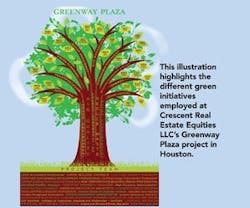Utilizing the Best Technology and Products
Whether it’s the lights, plumbing, HVAC, or the need for more environmentally friendly appliances and finishes, each product selection you make requires research on what’s best, what’s cutting-edge, and what won’t break the budget in tight economic times.
The usual rules apply when looking for energy-saving products. Ask questions of manufacturers. Is it ENERGY STAR labeled or otherwise third-party certified? Does it contribute to LEED credits? Talk to peers who have implemented new products and see what they think about performance and pricing. “My advice would be to utilize every resource available (i.e. websites, webinars, colleagues, trade publications, seminars, and technical manuals) to research the technology you’re looking to implement,” says Tom Tolan, national director of engineering at Los Angeles-based Lowe Enterprises Real Estate Group (LEREG). “After you’ve decided on the technology, locate facilities that have already implemented it, and see for yourself if it is working as designed. Discuss with the personnel how they are operating and tracking the performance, and see if it applies to the application you’re looking into. I don’t believe there is one technology that fits all.”
In his 10 years at LEREG, Tolan has made a short list of the most effective and efficient technologies he’s worked with. “I would have to say that the installations of variable frequency drives (VFDs) throughout the country [are the most effective at reducing energy consumption]. The reason they’re so effective and efficient is because of cost vs. savings. The cost of VFDs has gone down dramatically while electricity costs continue to go up. And, most utility companies offer rebates/incentives for the installation, and almost all simple paybacks are well below 2 years,” he says. He offers another best practice: “We have branched out and installed VFDs on domestic water pump motors along with closed-loop condenser water pump motors, and it has proven to be highly effective and efficient, given that the correct control points are used to signal the drive.”
LEREG also employs motion sensors and LEDs to save energy on lighting, GPS irrigation controllers to reduce water consumption, portable data loggers and kWh meters, and various other energy-management technologies. Crescent Real Estate Equities LLC, Fort Worth, TX, which also utilizes VFDs among its energy-saving product choices, has recently taken a portfolio-wide energy-savings initiative that includes replacing outdated lighting fixtures with T8, T5, and LED technology. Crescent has also begun upgrading and replacing plumbing fixtures and fittings with new-technology water-conservation controls, decreasing kilowatt use of mechanical pump energy through reduced water volume consumption – a great example of how smart upgrades in one area can impact total building performance.
Liberty Property Trust in Malvern, PA, offers a simple change that’s achievable on almost any budget: use high-efficiency LED exit signs. “Many exit signs in today’s buildings use older, incandescent and fluorescent or CFL technology, which requires frequent maintenance due to the short life span of the lamps. LED exit signs use a very low amount of energy and require very little maintenance,” says Marla Thalheimer, sustainability manager at Liberty Property Trust.
On the other hand, certain products might not have an easily monitored impact on energy or building operations, but they could be doing a world of good in other ways. In an effort to enable buildings and tenants to be “high performance,” Liberty Property Trust is focusing on improving indoor air quality to reduce sickness and provide a more comfortable and productive environment. Recent advances in low- and no-VOC finishes have been the key. “Keeping harmful toxins out of the air is extremely important to us as we strive to create extraordinary work environments,” says Thalheimer. “In addition to low-/no-VOC paints, we require the exclusive use of Green Seal Certified cleaning products in our managed properties.”
While green (or supposedly green) products are coming out of the woodwork, don’t fall into the trap of judging a book by its cover. “There are a lot of new and exciting products on the market today, which can be overwhelming,” says Thalheimer. “My advice would be not to forget the tried-and-true measures that you know will produce energy savings. For example, technology like energy monitoring and a good, old-fashioned lighting retrofit can produce enormous savings. If you don’t know where to start, find a good energy auditor. There are lots of incentives out there today, so check with your local utility company to see if they can help you.”
Read about our Who's Who organizations and their best practices in the following articles:
| Benchmarking and Monitoring |
| Utilizing the Best Technology and Products |
| Getting Everyone on Board |
| Looking Ahead: Regulations |
| Reducing Use and Waste |
| Managing the Effort Top-Down and Bottom-Up |
We hope that the experience and successes of our Who’s Who leaders will supplement your team’s best practices. Do you have best practices to share with your peers? Leave a comment at the end of this page or send an e-mail to [email protected].
